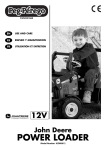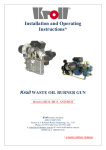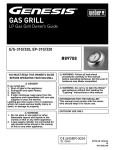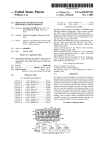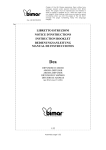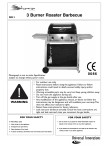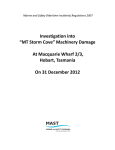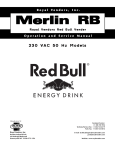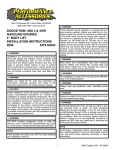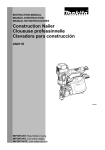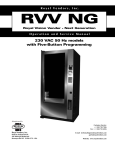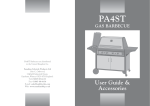Download Installation and Operating Instructions
Transcript
Installation and Operating Instructions Kroll WASTE OIL FIRED BURNER GUN MODEL BR 5 Kroll Heaters Australia ABN 67108717451 Fact 2, 36 Amberley Crescent, Dandenong, Vic, 3175 Phone: 03 9791 3082 Fax: 03 9791 3048 E-mail [email protected] Web www.kroll-heaters.com.au FREECALL 1800 805 243 INDEX Pg Introduction 2 Topic 1 Principle of Waste Oil Burning 3 Topic 2 What is “Waste Oil”? 4 Topic 3 Mounting the Burner Gun 4 Topic 4 Oil Feed 5 Topic 5 Starting and Running the Burner Gun 10 Topic 6 Maintenance 13 Topic 7 Faults, Possible Causes and Remedies 16 Appendix Short Maintenance Guide, Exploded Parts View & Circuits 18 1 Introduction Thank you for choosing a Kroll waste oil fired burner. This manual will explain how to install, operate and maintain your burner. Kroll burners can be fitted to air furnaces or heaters which push out warm air, or to boilers, to produce hot water. It’s important that you also read the separate manual about that apparatus in conjunction with this burner manual. When you burn waste oil in a Kroll burner, provided you have it adjusted correctly, and attached it to a compatible heater or boiler, it will run cleanly and reliably. BUT, in exchange for being able to run on this free or inexpensive fuel, you have to put up with inconvenience of some extra maintenance compared to using gas, heating oil or electricity. If you are not prepared to carry out this extra maintenance, then, to be blunt, you have bought the wrong burner! We believe that in order to look after your burner, you need to have a good understanding of how it works. So please read through this manual. 2 TOPIC 1: Principle of Waste Oil Burning Waste oil has a high flash point, compared to conventional heating oil. This means it does not burn easily. Your Kroll burner gun is designed to filter, pre-heat and emulsify the waste oil with air bubbles, before sending it to the nozzle, where it is atomized into a fine mist for reliable and efficient ignition & combustion. The pre-heating is the key feature, and for standard waste oil from car sumps this should be 80 to 85 degrees C. This heating makes the oil easy to vapourise. Any burning after ignition requires a fuel supply and air supply. The Kroll burner therefore requires adjustment of the fuel and also the air mixture for successful smoke free combustion. When the burner arrives & is unpacked it will be preset to a successful combination of air/fuel. The high furnace temperature reduces the contaminants in the waste oil to a grey coloured residual ash, which is trapped in the furnace and heat exchanger chambers or tubes of your air heater or water boiler. TOPIC 2: What is “Waste Oil”? When we talk about waste oil we mean almost any kind of used automotive oil – engine oil, diff oil, gearbox oil, and automatic transmission oil. There are some synthetic oils around which don’t burn well on their own. These are usually exotic high performance oils used in racing cars or specialized mining machinery, so they’re not usually found in large volumes. High performance brake fluid is also synthetic. Used synthetic oil normally burns without problems. It’s the new synthetic oil that is difficult to burn. If small amounts of synthetic oils are present in your waste oil it’s not a problem. They travel through and are burned up. But it is the mineral base oil which provides the heat. In fact waste oil has the same calorific value (heating energy) as conventional heating oil. The contaminant to be most vigilant for is paint thinners. Logically, you’d expect this to be volatile and dangerous, but in fact, paint thinners usually reacts with sump oil to form a jelly like substance, which will not burn properly. Your Kroll burner will not run on a mixture of sump oil and paint thinners. Fortunately, thinners have a fairly distinctive smell. If you’re collecting your own oil, you ought to be able to detect, and avoid it. If you’re buying your oil from a waste merchant, it is important that you tell him that paint thinners is absolutely unacceptable. It will cause rapid damage to your burner gun. 3 TOPIC 3: Mounting the Burner Gun onto the boiler Insert the blast tube (part #12, see the appendix for part breakdown) into the furnace opening and mount it using the pair of Cshaped alloy clamps and insulating gaskets provided, see right The drip hole in the blast tube end should always face down. Have an electrician wire up the seven-pin plug (9) to your air heater/boiler. Note: If the BR 5 is being inserted into a cast-iron boiler a stainless steel fire-tube of 250 mm diameter by 250 mm length should be centralized around the flame location inside the combustion chamber of the boiler. This will assist in achieving a clean burning of any peripheral spatter of the waste oil. The spatter waste oil hitting the fire-tube is burnt off by the flame. The pictures right & below show fire-tube inside the combustion chamber of Sime 1R-9 Water Heater. Heat exchanger & combustion chamber of typical cast iron water heater shown right. Note the fire-tube inserted in the combustion chamber at the bottom. 4 TOPIC 4 Waste Oil Supply Main Storage Tanks The great appeal of a Kroll burner is it’s very low running cost. But this is also its ‘Achilles’ Heel. The fuel is cheap because it’s dirty. Your Kroll burner is very tolerant. It will run on just about any kind of waste automotive oil, but it will not run on water or sludge. The best way to eliminate fuel related problems is to have a good storage tank arrangement. We strongly discourage feeding your burner directly from 205 litre drums – even as a temporary measure. We recommend you put in two proper storage tanks of between five thousand and twenty thousand litres capacity, depending on your expected consumption. Given time, the water and sludge will settle to the bottom. It is ABSOLUTELY ESSENTIAL that the oil feed outlet from your tank is well above the lowest point. We recommend that at least 10% of the tank’s capacity be below the outlet. You should have another outlet at the lowest point, to drain off accumulated water and sludge, once or twice each year. If possible, locate this drain at the opposite end to the feed outlet and slope the tank that way slightly. It is very important to have two storage tanks, to allow settling time. Most waste oil has moisture and dirt suspended in it. If you can let it settle for 3 or 4 weeks, a lot of the rubbish will fall to the bottom. Every time you get a new delivery of oil, not only does it have its own suspended contaminants, but when you pump it into your tank, it stirs up some of the sludge that has settled out of previous deliveries. With two tanks, you can be running one, while the other is settling. We recommend you fill both tanks during Summer, because the longer it sits there, the better it gets. We recommend the building of a bund wall. This can be as simple as an earth ‘dam’ around your tank or it can be constructed with a concrete slab and blocks, painted with a sealant on the inside. 5 Day Tank A certain amount of fine silt and metallic dust will stay suspended in the oil. This doesn’t affect reliability in the short term, because it passes easily through the burner gun. However, the fuel is also the lubricant for the moving parts inside the burner gun, and all this abrasive material can cause premature wear. A tank of between fifty and one thousand litres, called a ‘day’ tank or ‘header’ tank, should be located near your heater, and fed from your main storage tank. The standard domestic heating oil tank is ideal. It’s about 400 litres and can usually be found just by asking around, because many homes have switched to gas heating. In conjunction with a good filter, this ‘decanting’ of the waste oil eliminates much of the abrasive material and reduces the ash build-up in your heater/boiler. Even after settling and filtration of your oil, you can still expect a certain amount of “wear and tear” in your burner gun. In a greenhouse heating application, where the burner is working 7 days a week, virtually all year round, you could be looking at up to $1,500 in a worst scenario, to recondition your burner gun each year. In a factory or workshop heating situation, you can expect to go for 4, 5 or 6 years, before any major wear occurs. Piping from Bulk Tank to Day Tank Your Kroll agent can advise you on the best arrangement for the main storage tank, pipeline, day tank and filtration. It will vary according to the topography and layout of your site. Here are some options, but first a few words about the pipe itself. If the pipe is exposed to risk of damage or rupture from vehicles or machinery, etc, it should be of galvanized steel. Otherwise, high grade poly or flexible, petrol and oil resistant hose is fine, provided it complies with local regulations. Give your choice of pipe careful consideration and be vigilant. Sump oil spillage or leakage is a very serious matter. The risk is extremely low, provided you plan your installation well and take proper precautions. Gravity Feed System If you have some fall from the main tank to day tank this works well, but be aware that oil gets very thick when the temperature falls. A generous flow in summer. Through a ¾ inch (19mm) pipe, can reduce to a pitiful trickle when winter comes. Allow for this by using large diameter pipe (up to 2 inch /50mm, if it’s traveling 30 metres or more), having only gentle curves (not right angle bends), and if possible run inside the building or underground, where it’s not so cold. If the distance from your storage tank to your day tank is less than five metres, 1 inch (25mm) pipe is adequate, provided you have at least a one metre fall. 6 Of course, you have to control the flow of oil into the day tank. A conventional full flow float valve (eg, Philmac brand) can be mounted in the day tank. (If it has rubber O- rings they should be replaced with a neoprene type which is unaffected by oil.) Float valves can leak if some grit gets under the seat. You need a safety back up. You could fit an electric motorized valve, or solenoid valve to the main pipe, activated by a float level switch, mounted in the day tank, above the float valve. Or, it can be very simple. From an overflow outlet near the top of your day tank, excess oil would fall into a sizeable container – twenty litres or so. When it gets heavy enough, the container pulls on the lever of a ball valve, thereby closing off the main pipe (see diagram, below). Day tank with gravity feed from storage tanks, showing safety shut off valve in case of overflow. Pump Transfer System If you cannot gravity feed to the tank, you will have to pump the oil. There are a variety of pumps available for this job. Your Kroll agent can advise you. A simple float switch fitted in the day tank will stop and start the pump, to maintain the desired level in the day tank. Again, we believe it is imperative that you have a safety back-up system in case the float switch fails to switch off the pump. We suggest a simple system. From an overflow outlet near the top of your day tank, excess oil would fall into a sizeable container – twenty litres or so. (Remember that oil is coming into the day tank under pump pressure, so you’ll need a generous sized overflow outlet, say 2 inch (50mm) to match it. 7 When it gets heavy enough, the container breaks the electrical connection between the float switch and the pump. If your float is set up properly, it’s very unlikely that it will ever fail. But if it does, the consequences are severe enough that you simple must have a safety back-up. With the pump transfer system you can afford to use a smaller diameter pipe, but we recommend at least one inch (25 mm). Oil Feed from Day Tank to Burner Gun Your day tank must be higher than your burner gun to ensure a good gravity feed. Fit the ball valve at the outlet point and then run a 25 mm flexible hose directly to your burner gun, connecting at the preheat tank, in place of the plug *(31). We recommend you use a generous length of hose that runs down to the floor and up to the burner. This will enable you to take the burner on and off the heater or boiler, without having to disconnect the oil line. We normally use a transparent flexible petrol and oil resistant PVC hose (eg. Nylex TMP. That stands for ‘transparent, multi purpose’, and the hose has a thin red line on it). It’s important that 90° elbows are used at each end. If the hose is fitted in a horizontal position it will eventually sag and kink. Filtration You must have some form of filtration in your oil supply system. Consult your Kroll agent for advice on the best type and size to suit your needs. 100 Micron is a good filter element size. De-Gassing As the oil heats up in the pre-heating tank, it gives off small amounts of gases and water vapour. Also, as it heats up, the oil expands. We have provided a short length of ½ inch copper pipe attached to a hydraulic coupling on top of the pre-heating tank. (64), to vent these gasses off. We want you to fit a length of ½ inch hose to this, run it up to the roof of the shed, or at least higher than your day tank. The oil will rise, in the de-gassing pipe, to the same level as the tank that is feeding it. It’s normal practice to leave the pre-heating on all the time during winter. This way your burner will always be ready to fire up. If you switch the power off to the burner, you’ll have to wait about ten or fifteen minutes each time, to allow the oil to heat up before you can start it. It is most unlikely to start reliably with cold oil. It’s best to use a transparent or semi-transparent PVC hose that can handle warm oil (up to about 50°C). It’s much better if you can see the oil level in this de-gassing pipe. THE VOLUMETRIC PUMP & OIL CONSUMPTION The amount of oil your burner gun will use is determined by where you set the hand wheel, (53). This chart shows the approximate consumption for the BR 5. Model BR5 l/hr kW 1 1.5 17 2 2.7 30 Position on Hand-Wheel 3 4 3.6 4.5 40 50 The higher the setting, the bigger the flame. 8 5 5.3 58 6 5.5 60 To adjust the hand wheel, loosen the knurled lock nut, line up the desired position of the hand wheel with the index mark & tighten it up again. CHOOSING THE CORRECT SETTING FOR YOUR HEATER OR BOILER The flame should never touch the sides of the furnace. If it does, it’s highly likely that the atomized mixture will condense into wet oil and you’ll get incomplete combustion and wet oil in the bottom of your furnace. If the flame hits the back of the furnace (but not the sides), and you don’t want to run at a lower setting, it may be possible to erect a ‘target’ of ceramic tiles or fire bricks there. This will protect the back of your furnace. If your boiler is rated at 50 kW we recommend setting the flame to approximately 10% less, so, for the BR5 a maximum setting of betwwen ‘3’ & ‘4’ on the hand wheel. SECONDARY AIR Efficient combustion requires the correct ratio between oil and air in your furnace. This air (oxygen) comes into your furnace in two ways. The primary air is drawn in through the pipe, (66), and mixed (emulsified) with the oil, in the compressor. The primary air volume is fixed for each burner. It’s the secondary air which must be adjusted to suit the oil volume and back pressure. We do this by loosening the knurled lock nut on the secondary air regulator, (11), and rotating this black disc, to increase, or decrease, the size of the ‘windows’. So, if you wind up the oil, you need to open up the secondary air also. Don’t be too concerned about this. It’s not a temperamental device. There is not one sweet spot where it runs perfectly, and runs badly on any other setting. There’s a reasonable range of settings where it runs smoothly. It’s hard to describe, but when you have established the oil setting where you want it, you should adjust the air opening, so that the flame is a bright yellow or orange colour, but ‘clear’ around the outside, so you can see the back of the furnace. To get a feel for oil/air ratio do this exercise. While looking through the viewing window of your water heater, slowly move the secondary air regulator disc, (11), through its range. At a very small opening, you’ll see the flame get very ‘sloppy’ and not clear around the outside. If you leave it like that for a few minutes it will start to run very rich and blow black smoke, start pulsating and run very roughly. When that just starts to happen, gradually open up the air, and you’ll see the flame ‘tighten up’, and become clear around the edge. As you keep opening the air, it will start to run to lean. The flame gets very ‘crisp’ and white smoke belches out the flue, and starts to leak out around the burner mount. If you go too far, the flame will die. Your best and easiest guide is what you see at the top of the flue – at least initially. After a while you’ll learn to read the flame quite well. IF YOU’RE GETTING GREY OR BLACK SMOKE, IT’S TOO RICH AND NEEDS MORE AIR. IF YOU’RE GETTING WHITE SMOKE, IT’S TOO LEAN AND YOU NEED TO CLOSE THE AIR DOWN A LITTLE. If there’s no smoke at all, then you’re pretty close to the mark. If in doubt, I favour setting a tiny bit on the rich side. If it’s too lean, it will still run okay, but may be a reluctant starter. Like a car, they always start better if they’re a bit rich. If it is reluctant to start, the first thing to do (if you’re sure you’ve got the oil at the nozzle, and it’s had time to pre-heat properly) is close the air down a bit and try again. 9 Topic 5 Starting and Running the BR 5 Before attempting to fire up the burner gun, it is important that you have a reasonable understanding of how it works, particularly the sequence of the various functions. Operation Overview When the thermostat calls for heat, the burner will not fire-up straight away. First it the motor spins up for a PURGE period of about 10 seconds. The purpose of this is to remove un-burnt fuel & vapour in the furnace. It does this by blowing air into the furnace from the secondary air fan, (5). This dilutes the unburnt fuel, and then the electrodes, (14), ignite the weakened mixture. You’ll get a small ‘poof’ as this happens. The purge goes on for about 10 seconds, so the fan can push out the gases. You’ll always get a small amount of smoke out of the flue at this time. During the purge period the photo-electric (PE) cell, (6), which is located in a small plastic socket on the right hand side of the burner gun ‘barrel’, is checking to see that there is no light (ie, no flame) present. After the initial ‘poof’ and subsequent purging, there should be no fuel present, and hence no flame. If there is a flame present, then the PE cell will not allow the burner gun to proceed to the firing up stage. It will purge for a bit longer than normal and then shut down on ‘flame failure’, ie, the red light, (which is also the reset button) comes on, on the control box. When the burner goes off on flame failure at the end of the purge period, it’s because the PE cell can ‘see’ some light. The most likely cause of this is strong sunlight shining through the viewing glass. The PE cell is very sensitive, and thinks it can see a flame. Some tape over the viewing glass will fix this problem. Assuming that all is in order at the end of the purge period (ie, no light visible) the PE cell sends a message to the control box, which then sends power to the three-way electrovalve, (33). During the purge, up to this point, the warm oil in the pre-heating tank is being pumped around in a circle, ie, it is drawn out of the pre-heating tank via the inlet pipe, (38), into the metering pump,(57), goes along the pipe, (55), into the electrovalve, (33), out the top and back along the other pipe, (61), and falls back into the pre-heating tank via the de-gassing T-piece,(64). At the end of the purge, the electrovalve closes off the top outlet, and opens the lower one, to a small elbow that leads directly into the compressor. This is where the warm oil is mixed, or emulsified, with the primary air, and sent on to the nozzle. The primary air is drawn in through the copper pipe, (66) When this mixture of warm oil and air bubbles reaches the nozzle, it comes out as a fine spray. (atomization) The secondary air, which is rushing down the black blast tube, (12), and swirling when it passes through and around the windmill shaped disc, called the diffuser plate, (15), controls the shape of the spray of this atomized oil, and supplies the oxygen, that enables it to be ignited by the electrodes, (14), which are throwing a strong spark throughout this whole purge and firing up process. (The spark stops about 14 seconds after the flame starts.) Listen carefully for the ‘click’ of the electrovalve, (33), and a slight change in note of the burner – which signals the end of the purge period. (Sometimes, the click is so soft you need to place your finger on the electrovalve, to ‘feel’ it click.) The burner gun should fire up within 2 or 3 seconds of the click. At the end of the purge period, The PE cell (6), (which, during the purge period, was checking to make sure there was NO light present) reverses its role. It is now checking to make sure there is a light present, and if it doesn’t see one within about 10 seconds, it will shut the burner down on ‘flame-failure’. 10 PRIMING THE BURNER GUN WITH OIL You cannot attempt to fire up the burner gun until it is primed. i.e., inlet pipe and most importantly, the pre-heating tank, are full of oil. Also, if the pre-heating rod, (50), is activated without oil around it for more than about 10 minutes, it may suffer damage. Open the day tank outlet and watch the oil flow down into the gun. After a short delay, while it fills the pre-heat tank of the gun, the oil will appear in the de gassing pipe and climb up until it has reached the same height as the oil level in the day tank, see right for an example of a BR5 mounted on a furnace. The degassing pipe is circled. PRE-HEATING When you’re starting from scratch, ie, the burner gun and oil are cold, you’ll need to allow 30 minutes to ensure that the oil in the pre-heat tank is up to temperature. If you wrap your hand around the bottom of the pre-heat tank, you’ll get a feel for how hot it gets. The waste oil must heat up to 80°C for automotive waste oil FUEL TYPE Automotive Waste Oil Light Oil, Diesel or Kerosene Bunker Oil Fuel oil + Waste Oil blend Vegetable oils RECOMMENDED THERMOSTAT SETPOINT 75-85°C 10° C 90° C 80-90° C 40–60° C STARTING THE BURNER If you are starting the burner for the first time, or if you have just sorted out a problem (such as water in the burner gun, or a blocked filter), then we suggest you start at #1 on the hand wheel. At this oil setting, you’ll only need a fairly small opening of the secondary air regulator (11), a ‘window’ opening of about 5mm or 6mm. STARTING By now you have fitted the de-gassing pipe, primed the gun with oil, allowed it to heat up to 80°C, set your hand wheel on #1 and set your secondary air regulator at a small opening. Increase the boiler thermostat up, burner will start to purge. After about 10 seconds, you’ll hear the click of the electrovalve, (33), and your burner should fire up within two or three seconds. INCREASING THE FLAME SIZE When the burner has been running on a small flame, in a stable manner for five minutes or so, you can gradually wind it up to your desired power setting. 11 AUTOMATIC RESTART If the burner is running and the flame dies for some reason (eg: lack of oil), instead of shutting down on ‘flame failure’ ten seconds after the flame disappears, the burner control box is programmed to attempt one restart, ie: ten seconds after losing sight of the flame it goes back to the purge period, purges for about ten seconds, the magnetic valve clicks open again… and this time, if it doesn’t fire up within ten seconds, it shuts down on flame failure. The red (flame-failure) light comes on, and you have to wait about fifty seconds before you can reset the flame-failure lock out, by pushing on the red illuminated button, and trying again. (NOTE: It will not automatically attempt a restart if it fails to fire up on an initial start up. It only does that if the PE cell loses sight of light while it’s actually running.) (NOTE 2: The latter BR Series burners have been fitted with the LMO24 intelligent controller. See the Pgs 25 to 27 at rear of manual) FLAME FAILURE If it fails to fire up after three or four attempts, it’s no good just repeatedly pushing the flame failure reset button. You have to look for the reason, and, most importantly, you need to take the burner gun off the heater/boiler and look to see if it’s dumped some wet oil in the furnace. If it has, this needs to be removed by wiping it out with a rag. (See faults, possible causes and remedies) If you don’t wipe out most of the oil, when you eventually find the fault and get the burner fired up, very soon afterwards, that wet oil will heat up and start vapourising, and the gases ignite into a ball of flame, and the burner gun starts backfiring. It’s a bit scary the first time it happens, with vibration, and smoke coming out around the mounting bracket. If it’s only fairly sedate, let it run for a while on a small flame, say #1 on the hand wheel, and it will dry out that wet oil and start running smoothly. But, if it’s a bit violent, you must switch off the burner gun, remove it, and dry out the wet oil with a rag before attempting another start up. 12 TOPIC 6: Maintenance It’s hard to be specific about how often each maintenance procedure needs to be done, because it depends on the nature (dirtiness) of the waste oil you’re burning, the number of hours you’re running and/or the number of litres you’re using. The only safe way is to start out by doing the maintenance more often than necessary, and gradually increasing your intervals according to what you find. Before commencing any maintenance, disconnect all power. BURNER GUN OIL STRAINER The large oil strainer (29), should be checked about once every 2 weeks. WATER AND OIL DRAIN It’s normal for a bit of water to accumulate in the bottom of the pre-heat tank. It should be drained off through the drain cock (32), at least once a week. If you want to completely drain the pre-heat tank, remove the large strainer (29). The drain cock (32), is ineffective for this purpose, because of its small aperture and internal galleries in the pre-heat tank. PRE-HEATING ROD Over time, a tough coating of carbon, or ‘clinker’ will build up on this rod, (60). IT IS ABSOLUTELY IMPERATIVE THAT IT BE REMOVED AND CLEANED AT LEAST TWICE EACH SEASON. As the clinker builds up, the rod works less efficiently. If the coating is too big it is very difficult to remove the rod for cleaning. To remove the heating rod, firstly disconnect and remove the thermostat (62), from it’s pocket. (Take note of where the wires go, so you can refit them correctly. Write it down.) Please do not try to unscrew the heating rod with a shifting spanner. It’s important that you equip yourself with a 32mm RING spanner. A ring spanner is preferable to a socket, because you can see that the whole heating rod is turning, and not just the hex nut. Once the rod is out you can remove the carbon. There’s no easy way to do this that we’re aware of. You just have to scrape away at it, and finish it off on a wire wheel. WHILE THE HEATING ROD AND THE LARGE STRAINER ARE OUT, IT IS VERY IMPORTANT THAT YOU FLUSH OUT THE PRE-HEAT TANK! This sludgy material is made up of carbon that has flaked off the heating rod, and contaminants that have settled out of the oil, in both the upper and lower galleries of the pre-heat tank. This can be done using petrol or diesel, and a toothbrush or similar small brush. 13 NOZZLE PIPE ASSEMBLY It’s very important that the components are mounted according to the specifications. If the clearances between the nozzle, diffuser plate and electrodes are not correct, the burner may not start and run properly. Use a ruler initially to ensure that the clearances are about right. See image below. DIFFUSER PLATE By looking through the sight glass when the burner is running, you can monitor the build-up of carbon on the diffuser plate,(15). It’s important that the vents are not clogged. You should not let it build up too much, because even though it may accumulate over a week or two, it reaches a certain point and then the build-up and efficient combustion can accelerate rapidly. There’s no easy way to clean it. You just have to scrape it off. We have had some success with spraying it with oven cleaner and leaving it sit for a while. To clean it thoroughly you really need to take it off the nozzle pipe. This enables you to soak it in petrol or caustic soda, which helps soften the carbon. After scraping you can finish it off on a small wire wheel. Like all the maintenance procedures we recommend, they should be done before they have to be done. Note that the hole in the middle of the diffuser plate is not symmetrical. It is cut away more on the top, to accommodate the electrodes. ELECTRODES A visual inspection will tell you whether the tips of the electrodes (14DX/SX) need cleaning. It’s important that neither of these electrodes is touching or too close to the diffuser plate, or you’ll find the spark will jump to the plate, instead of between the electrodes. If an electrode ever comes loose inside its ceramic casing, you can tighten it up again with the nipple that the high tension lead clips on to. That nipple is actually a threaded nut, screwed on the end of the electrode wire itself. Check the ceramic casings for cracks at least once each season, and replace them when necessary. 14 If the electrodes and nozzle pipe assembly is covered in wet oil, it should be disassembled and cleaned. NOZZLE Remove the nozzle assembly, (16), with a 14mm spanner. Unscrew the front part (17mm spanner) from the rear part and in between you’ll find a small ‘spiral’. This doesn’t spin itself, but it causes the emulsified oil to ‘spin’ as it leaves the nozzle and this creates better atomization. This spiral needs to be checked once a month because it can get a build-up of rubbish or carbon in the splines. The spiral is symmetrical so it can go back in either way, but take care that it is located properly, and doesn’t flip sideways when you are reassembling the nozzle. PHOTO-ELECTRIC CELL (6) Over time the PE cell will get a bit of soot on it, which affects its ability to ‘see’ the flame. It should be pulled out and wiped every two weeks or so. If it shows signs of being heat affected, it’s probably because the heater/boiler is overdue for cleaning and the excess back pressure is pushing heat back into the burner gun. Because of the importance of the PE cell, it would be wise to keep a spare one on hand. HYDRAULIC COUPLING (64) We have fitted this so that when you disconnect the de-gassing pipe, it doesn’t drip oil everywhere. However, you will need to clean both male and female parts occasionally, to ensure that the opening is clear and that the coupling goes together without undue downward pressure. If it leaks oil, you may need to replace the O-ring in the female side. ELECTROVALVE (33) These units rarely give trouble, but it’s wise to clean them at least once each season. Take careful note when disassembling, of what goes where. Unplug the 3-pin plug, and take the electrovalve off the burner gun by unscrewing the three small pipes attached to it. Undo the top nut and slip the magnetic block (ie, the energizer) off the post. Unscrew the four small Phillips head screws to reveal the plunger and spring. Wash everything in petrol, blow it out with compressed air if available, and reassemble. END OF HEATING SEASON After long operating intervals (after the heating season, for example) carry out the following operations: 15 Put some lubricating oil (possibly light oil) into the primary air inlet pipe (#66) of the compressor Start the burner for a short while (a few rotations only) to allow the lubricating oil to be well distributed into the rotor and blades of the compressor. This will inhibit eventual corrosion and the eventual sticking of the blades in the compressor rotor as water can always be present in waste oil. TOPIC 7 FAULTS, POSSIBLE CAUSES AND REMEDIES Goes out on flame failure at the end of purge period (ie magnetic valve does not ‘click’). • PE cell is faulty • Faulty or dirty electrovalve,(33), is allowing oil through to the nozzle during the purge period, and the burner is firing up prematurely. • Control box, (8), is faulty. No ignition • Check for ignition spark, or, Electrodes not positioned properly, or need cleaning. • Mixture too lean. Close air down a bit and try again. • No oil getting to nozzle. Check that pre-heat tank is full and that the pipes and magnetic valve aren’t blocked. Check that the hand wheel, (53), is set OK • Too high water content in fuel. • Oil is not combustible for some reason-eg, contains paint thinners, or a high percentage of some 100% synthetic oils. Drain it out, get a known sample that you’re sure of, and try again. • Oil too cold. Check pre-heat thermostat, (62), is set to 80°C and give it time to warm up. • Nozzle blocked • Diffuser plate, (15), too dirty • Too much back pressure in heater or boiler. Overdue for cleaning. • Flue blocked. Perhaps the hat has fallen down? Burner fires up okay but then shuts down on flame failure soon after. • Check PE cell for soot. Perhaps it can’t see the flame. • PE cell faulty. • Control box faulty 16 Burner fires up okay, runs for a while, but then starts to run very badly, pulsating and making black or grey smoke. • Mixture too rich. Open air up a bit. • Wet oil in furnace. When it warms up, it vapourises and erupts into a ball of flame. Remove burner gun, and dry out the furnace as much as possible with rags. If the wet oil is sticky and stubborn, soak it with some diesel of degreaser and then dry it out. DO NOT USE PETROL!!! If furnace is hot, let it cool down before cleaning and attempting to re-start. • If fire bricks are used in the furnace, let them cool down, remove them, clean as well as possible and refit them. • Turn the gun down to a small flame, ie, set metering knob to #1 and close the air down accordingly. Fire it up, adjust the air a bit if necessary, and let it run on a small flame until it dries itself out-maybe half an hour or so. • If, even on a small flame, the furnace erupts again, and the burner starts pulsating, switch it off, wait five minutes, and try again. • When it’s been running with a stable flame for a while, you can ease the flame back up to your normal settings. What causes wet oil in the furnace? • Possibly a blocked filter or too much back pressure, or an empty day tank. The burner is running, but as the filter blocks, it gradually starves for oil. It struggles on, running badly, before it dies, and during this time, the poor combustion means unburnt oil accumulates. If you were near the heater when it was struggling you’d notice and do something. But if it happens in the middle of the night, before you can fire it up again, you need to fix the original cause of the wet oil. Flame too big for furnace. • Too much wear in burner gun; specifically in the compressor. If the compressor liner (26) and rotor blades (25) are too worn. Your burner will not atomize properly. Instead of getting a nice fine mist at the nozzle, you could be getting large droplets of oil, which do not burn well. This sort of wear does not occur overnight, so there is usually plenty of warning. If your gun is noisy, and is not burning well, contact your Kroll agent before winter. Don’t ignore the signs and leave it till the last minute. Pre-heat tank is hot, but burner won’t even start to purge. • Check flame failure light. Push to reset. • Check room thermostat is calling for heat • Check safety thermostat in heater/boiler. It might be tripped 17 Model BR 5 Short Maintenance Guide ATTENTION! before starting any maintenance work, always disable both the main switch and the toggle switch on the burner to prevent damage to the burner & yourself 1- Clean the oil filter(s) on the BULK oil supply periodically (weekly if using waste oil). 2- Clean the oil filters (#29) in the burner 2 weekly for #29 3- Open the drain cock (#32) once a week/fortnight to release possible water. 4- Clean the heat rod TWICE PER SEASON (#60). Use a scraper and wire wheel. Then flush out the pre-heater tank (#27) to get rid of sludge at the bottom of the tank; use petrol and a toothbrush. 5- Clean the diffuser (#15) monthly, or every time the flame is not burning cleanly. The diffuser does tend to carbon up, so it must be cleaned. The nozzle (#16) should also be checked by removal & dis-assembly. 6- After long operating intervals (after the winter heating season, for example) please carry out the following operations: a- Put some lubricating oil (possibly light oil) into the primary air inlet pipe (#66) of the compressor b- Start the burner for a short while (a few rotations only) to allow the lubricating oil to be well distributed into the rotor and blades of the compressor. This will inhibit eventual corrosion and the eventual sticking of the blades in the compressor rotor as water may be always present in waste oil. STARTING THE BURNER AFTER 240V power removal If restarting the burner after a long period of burner inactivity, turn the main 240 VAC supply switch ON first, then wait for about 15 minutes until the oil is heated and then turn the operating toggle switch (#8a) of the burner on. The burner will now work correctly with hot oil. This should be read together with Topic 6, routine maintenance of the Installation and Operating 18 19 20 21 22 23 24 25 26 27




























